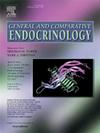Regulation of the neuroendocrine stress axis in response to ammonia exposure in rainbow trout: Pharmacological and transcriptional evidence implicating serotonin and multiple hypophysiotropic peptides
IF 1.7
3区 医学
Q3 ENDOCRINOLOGY & METABOLISM
引用次数: 0
Abstract
Ammonia is neurotoxic and exposure to high environmental ammonia (HEA) activates the hypothalamic-pituitary-interrenal (HPI) axis in teleosts. To gain insight into the neural factors that regulate the HPI axis in response to this environmental stressor, as well as elucidate potential interactions between these factors, we exposed rainbow trout to one of three ammonia levels (0, 650, 1000 μM NH4Cl) for 24 or 96 h and assessed the gene expression and circulating levels of key determinants of HPI axis activity. In parallel with circulating ammonia concentrations, plasma cortisol levels increased dose-dependently after 24 h of HEA exposure and partially recovered after 96 h. HEA exposure also elicited dose-, time-, and brain region-specific changes in components of the central serotonergic (5-HTergic; tph2, htr1aa, htr1b, htr2c), corticotropin-releasing factor (crfb), arginine vasotocin (avt, avtr1a, avtr2), and isotocin (it, itr) signaling systems. Moreover, while intraperitoneal injections of 5-HT1B and 5-HT2C receptor antagonists reduced basal cortisol levels, treatment with 5-HT1A and 5-HT2C receptor antagonists blocked the increase in plasma cortisol elicited by HEA. Finally, treatment with specific 5-HT receptor antagonists blunted the HEA-induced increases in brain preoptic area crfb, avt, and it expression. These findings implicate 5-HT and multiple peptidergic systems in the hypophysiotropic regulation of the HPI axis in response to HEA exposure and provide novel insight into the multifactorial neural circuitry mediating the neuroendocrine stress response in fishes.
虹鳟鱼对氨暴露的神经内分泌应激轴的调节:涉及血清素和多种垂体肽的药理学和转录证据
氨具有神经毒性,暴露于高环境氨(HEA)会激活硬骨鱼的下丘脑-垂体-肾间轴(HPI)。为了深入了解调节HPI轴响应环境应激的神经因素,并阐明这些因素之间的潜在相互作用,我们将虹鳟鱼暴露在三种氨水平(0、650、1000 μM NH4Cl)中的一种环境中24或96小时,并评估了HPI轴活性关键决定因素的基因表达和循环水平。与循环氨浓度平行,血浆皮质醇水平在HEA暴露24小时后呈剂量依赖性增加,并在96小时后部分恢复。HEA暴露还会引起中枢血清素能成分(5-羟色胺能;Tph2、htr1aa、htr1b、htr2c)、促肾上腺皮质激素释放因子(crfb)、精氨酸缩后叶催产素(avt、avtr1a、avtr2)和异源催产素(it、itr)信号系统。此外,虽然腹腔注射5-HT1B和5-HT2C受体拮抗剂可降低基础皮质醇水平,但5-HT1A和5-HT2C受体拮抗剂可阻断HEA引起的血浆皮质醇升高。最后,用特异性5-HT受体拮抗剂治疗可以减弱hea诱导的脑视前区crfb、avt和它表达的增加。这些发现暗示5-HT和多种多肽系统参与了HEA暴露对HPI轴的促垂体调节,并为鱼类神经内分泌应激反应的多因子神经回路提供了新的见解。
本文章由计算机程序翻译,如有差异,请以英文原文为准。
求助全文
约1分钟内获得全文
求助全文
来源期刊

General and comparative endocrinology
医学-内分泌学与代谢
CiteScore
5.60
自引率
7.40%
发文量
120
审稿时长
2 months
期刊介绍:
General and Comparative Endocrinology publishes articles concerned with the many complexities of vertebrate and invertebrate endocrine systems at the sub-molecular, molecular, cellular and organismal levels of analysis.
 求助内容:
求助内容: 应助结果提醒方式:
应助结果提醒方式:


